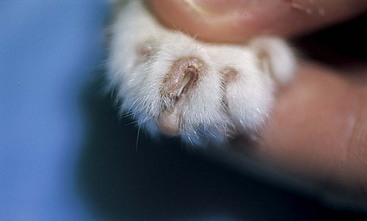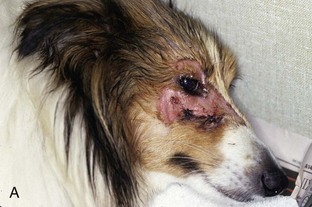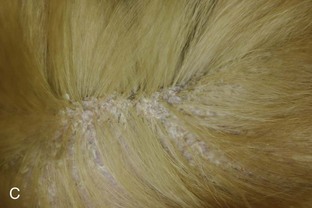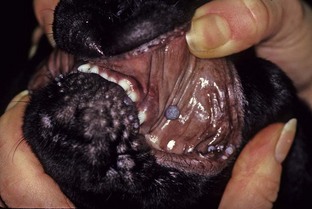CHAPTER 41 The Skin and Ear
Genodermatoses
Signs of congenital and hereditary skin disorders are most often observed during the first 2 to 3 months of age (Figure 41-1). In many cases, the genetic defect resulting in the disorder has not been fully characterized. Some of the described genodermatoses of dogs and cats are summarized in Table 41-1.
Infectious Diseases
Papillomas
Mucocutaneous viral papillomas are common in puppies. Smooth white lesions quickly progress to gray verrucous nodules that are often pedunculated (Figure 41-2). They are seen most often in the oral cavity and on the lips but may also occur on haired skin and conjunctiva. It is believed that various papilloma virus types have site predilections. The virus appears to be spread most often by direct contact but can survive for 2 months in the environment. There is a 1- to 2-month incubation period. Diagnosis can most often be made by clinical recognition in a puppy. Histopathology, if performed, reveals a hyperplastic and hyperkeratotic epidermis.
Dermatophytosis
Young animals carry an increased risk of developing dermatophytosis, reflecting their immature immune status and potential for exposure to carriers. Microsporum canis is the most frequent cause of ringworm in kittens and puppies. Entire litters can develop lesions, typically multifocal alopecic, mildly erythematous patches that progressively develop papules, scales, and hyperpigmentation (Figures 41-3 and 41-4). Frequently affected areas of kittens and puppies include the head, muzzle, pinnae, and distal limbs.

Figure 41-3 Paronychia in a cat caused by Microsporum canis.
(From Medleau L, Hnilica KA: Small animal dermatology: a color atlas and therapeutic guide, ed 2, St Louis, 2006, Saunders/Elsevier.)

Figure 41-4 Focal alopecia and erythema on the ear pinna of a cat with dermatophytosis.
(From Medleau L, Hnilica KA: Small animal dermatology: a color atlas and therapeutic guide, ed 2, St Louis, 2006, Saunders/Elsevier.)
Stay updated, free articles. Join our Telegram channel

Full access? Get Clinical Tree








